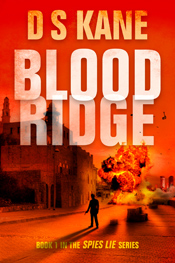Publishers will want to wrangle every last
penny of revenue from anyone’s first novel. One of their best sources is the
movie that can be made from a novelist’s first publication. The major reason is
that movies drive incremental book sales for the author, years after the book
has backlisted.
With that as their reasoning, for decades,
book publishers now tend to read every potential book with their eyes imaging
it in a movie theatre. The inevitable result is that novelists have started
studying screenwriting to ensure they can fulfill the publisher’s unstated
demand: Could a movie be made from this manuscript?
Since the most important way to develop
character is through dialogue and stage direction of the character (what they
do when they feel something), screenplay writing skills have become
increasingly important. Teachers like Eric Witchey use tools like E-D-A-C-E
(Emotion leads to Decision leads to Action leads to Conflict needs to another
Emotion), and A-B-C (agenda leads to backstory leads to conflict) where
dialogue and behavior driver character development.
My literary agent returned from meetings with
NY publishers with a third and fairly new requirement for fiction manuscripts,
based on what they feel is commercial: Eliminate all set-up and backstory
(except what can be medicine-dropped into the dialogue of the characters), and
have the story be solid action with no breaks. This is what you see when you’re
at the movies.
There are two superb teachers of screenplay
writing, Chris Soth and Jeffrey Alan Schechter. Soth (www.milliondollarscreenwriting.com) has a PDF
eBook called Million Dollar
Screenwriting: Make Money with the Mini-Movie Method, available from his
website for less than $50. Schechter wrote a PDF eBook called Totally Write Guide to Bulletproof
Screenplay Structure Guide, which he made available from his website, but
it was later turned into a software product called Contour, available from Mariner Software (http://www.marinersoftware.com/products/contour/)
for less than $50. Each one has a system that is far advanced past the old
three act structure that Chris Voglar (The
Writer’s Journey) suggests for story development. The objective is to
produce two-minute scenes, ideal for a movie.
I reviewed Schechter’s system and started
using it several years ago as a result of a conversation with Dennis Phinney of
ActFourWriters.com. Linda Rohrbough (a former ActFourWriters.com member)
suggested Soth’s system and I examined it last year. While there were
similarities, I found the mini-movie system offered a simpler design to my
plot. But, it wasn’t complete. When I cross-indexed the two systems, I finally
had a product I could use, complete with a way to justify the times when I
would have to break the rules. I developed a Microsoft Excel workbook that you
can use, complete with the cross-index embedded within, called BLANK Outline and Grading Sheet.xls.
I use the tool to craft the early stages of
my story. The instructions are simple. Enter your chapter and page number and
the Description of the scene into columns A, B and F, and ensure they
correspond to the aspect of your novel’s theme related to the scene in column
G. Do this for all 44 plot points, all 8 mini-reels. Each scene should be about
two minutes of real-time action in a movie, since the 44 plot points would then
become an 88 minute movie. The other way to see it is that all 8 mini-reels
would become a 96 minute movie. Examine the spreadsheet and do the math. It
works. In effect, your time line becomes what a movie of your story would
require in terms of minutes.
When you are finished, write the manuscript.
When it has gone through all of the critiques necessary to complete its
improvement cycle, review it against the Excel workbook and make corrections to
the workbook so they correspond in all aspects (page number for each chapter,
and all plot point descriptions. Send the workbook out with the manuscript to
your test readers, and ask them to enter letter grades (column H) and comments
(column I), enter evaluations (letter grades and comments) for every principal
character (rows 66 through 7), and grades and comments for every aspect of the
manuscript (rows 92 through 167). When you receive the returned workbook,
review their comments and make your final changes.
If you are working on plotting a novel and want
to use the BLANK Outline and Grading
Sheet.xls, you can copy it from this blog entry (below),
or request it from me via email (dskane@dskane.com).| MANUSCRIPT NAME, by AUTHOR - Full Manuscript Review Feedback Form | |||||||
| This form has been developed to help you as a reader to summarize your reading experience with this novel. Read the novel the way you'd read any published work. Do not edit the writing on a line by line basis. After each chapter, give the chapter a letter grade, using the guidelines presented below. Upon completion of each act, give the act a letter grade to help the author focus on what needs rewriting. Where a B or C is given, a quick one-liner identifying flaws may be noted at the right. Keep it brief. The alotted space is small for a reason. For an A, D or F, no further feedback is needed. After finishing each act, make some notes on the characters. If at any time, you are pulled out of the novel by an error or question of fact, please make a note in part three. Finally, once you have are done reading the novel complete your review by filling out Part 3. | |||||||
| Part One - Chapter and Act Grades | |||||||
| Chapter | Page | ACT 1 | Schechter Function | Soth Mini- Movie Reel | Description | Letter Grade | Comments |
| Act One | ` | ||||||
| 1 | 1 | 1- 1 - Innocent / Orphan | Meet Hero | Reel 1 - Our hero’s status quo, his ordinary life, ends with an
inciting incident or “call to adventure”. |
|||
| 2 | 1 - 2 - Innocent / Orphan | See Hero's Flaw in relation to the Stakes Character | |||||
| 3 | 1 - 3 - Innocent / Orphan | Meet Villans | |||||
| 4 | 1 - 4 - Innocent / Orphan | Villan slows the Hero Down | Reel 2 - Our hero’s denial of the call, and his
gradually being “locked into” the conflict brought on by this call. |
||||
| 5 | 1- 5 - Innocent / Orphan | Inciting Event - Hero now gets emotionally involved | |||||
| 6 | 1 - 6 - Innocent / Orphan | Hero's Goal as it relates to Stakes Character - Hero's Problem is now made clear | |||||
| 7 | 1 - 7 - Innocent / Orphan | Ally aids Hero by propelling him out of Status Quo | |||||
| 7 | 1 - 8 - Innocent / Orphan | Hero is ready to move forward with Stakes Character but stalls | |||||
| 8 | 1 - 9 - Innocent / Orphan | Villan stops Hero or threatens emotional stakes | |||||
| 8 | 1 - 10 - Innocent / Orphan | Depth of feeling between Hero and Stakes Character is made evident - They Hook up | |||||
| 9 | 1 - 11 - Innocent / Orphan | Villan threatens to take Stakes Character from Hero | |||||
| 10 | 1 - 12 - Innocent / Orphan | Hero decides he must save Stakes Character | |||||
| Chapter | Page | ACT 2 Part 1 | Schechter Function | Soth Mini- Movie Reel | Description | Letter Grade | Comments |
| 10 | 2a - 13 - Wanderer | Yes 1 | Reel 3 - Our hero’s first attempts to solve his problem, the
first things that anyone with this problem would try, appealing to outside
authority to help him. Ends when all these avenues are shut to our hero.
|
||||
| 10 | 2a - 14 - Wanderer | No 1 | |||||
| 10 | 2a - 15 - Wanderer | Yes 2 | |||||
| 11 | 2a - 16 - Wanderer | No 2 | |||||
| 12 | 2a - 17 - Wanderer | Yes 3 | |||||
| 12 | 2a - 18 - Wanderer | No 3 | |||||
| 12 | 2a - 19 - Wanderer | Yes 4 | |||||
| 13 | 2a - 20 - Wanderer | No 4 | Reel 4 - Our hero spawns a more grandiose, more extreme plan. He prepares for it, gathers what materials and allies he may need then puts the plan into action -- only to have it go horribly wrong, usually due to certain vital information the hero lacked about the forces of antagonism allied against him. We’re halfway home. On to the fifth mini-movie... | ||||
| 13 | 2a - 21 - Wanderer | Yes 5 | |||||
| 13 | 2a - 22 - Wanderer | No 5 | |||||
| 13 | 2a - 23 - Wanderer | Yes 6 | |||||
| 13 | 2a - 24 - Wanderer | No 6 | |||||
| 13 | 2a - 25 - Wanderer | Yes 7 | |||||
| 14 | 2a - 26 - Wanderer | No 7 | |||||
| Chapter | Page | ACT 2 Part 2 | Schechter Function | Soth Mini- Movie Reel | Description | Letter Grade | Comments |
| 14 | 2b - 27 - Warrior / Magician | Yes 8 | Reel 5 - Having created his plan to solve his problem WITHOUT changing, our hero is confronted by his need to change, eyes now open to his own weaknesses, driven by the antagonist to change or die. He retreats to lick his wounds. Mini-movies five and six might be viewed as one mini-movie of retreat followed by another mini-movie of renewed attack. Our hero, shaken, runs away from the antagonists he never knew were so tough, and licks his wounds. A mini-movie later, he’ll return with a new plan of attack. | ||||
| 15 | 2b - 28 - Warrior / Magician | No 8 | |||||
| 15 | 2b - 29 - Warrior / Magician | Yes 9 | |||||
| 17 | 2b - 30 - Warrior / Magician | No 9 | |||||
| 18 | 2b - 31 - Warrior / Magician | Yes 10 | |||||
| 19 | 2b - 32 - Warrior / Magician | No 10 | |||||
| 2b - 33 - Warrior / Magician | Yes 11 | ||||||
| 2b - 34 - Warrior / Magician | No 11 | Reel 6 - Our hero spawns a new plan, but now he’s ready to change. He puts this plan into action...and is very nearly destroyed by it. And then...a revelation. | |||||
| 2b - 35 - Warrior / Magician | Yes 12 | ||||||
| 2b - 36 - Warrior / Magician | No 12 | ||||||
| 2b - 37 - Warrior / Magician | Yes 13 | ||||||
| 2b - 38 - Warrior / Magician | No 13 | ||||||
| 2b - 39 - Warrior / Magician | Yes 14 | ||||||
| 2b - 40 - Warrior / Magician | No 14 | ||||||
| Chapter | Page | ACT 3 | Schechter Function | Soth Mini- Movie Reel | Description | Letter Grade | Comments |
| 3 - 41 - Martyr | Big Yes | Reel 7 - The revelation allows our hero to see victory, and he rejoins the battle with a new fervor, finally turning the tables on his antagonist and arrives at apparent victory. And then the tables turn one more time. | |||||
| 3 - 42 - Martyr | No | ||||||
| 3 - 43 - Martyr | Big No | Reel 8 - The hero puts down the antagonist’s last attempt to defeat him, wraps up his story and any sub-plots, and moves into the new world he and his story have created. | |||||
| 3 - 44 - Martyr | Final Yes | ||||||
| Guidelines for Letter Grades | |||||||
| A | A clean read with no speed bumps. I have no good suggestions for how this could be improved. | ||||||
| B | A few speed bumps or things you might want to consider are noted at right | ||||||
| C | The fictional dream imploded, or I got lost. Focus attention here on your rewrite. | ||||||
| D | I take it this chapter is a first or second draft. | ||||||
| F | Manuscript would be stronger if most of this chapter was deleted. | ||||||
| Part Two - Character Grades | |||||||
| Character | Letter Grade | Comments | |||||
| Guidelines for Letter Grades | |||||||
| A | A memorable character with believable objectives | ||||||
| B | A few inconsistencies or things you might want to consider are noted at right | ||||||
| C | Character motivation or behavior is hard to follow or not believable. | ||||||
| D | Either get to know this character, delete her or kill him off early. | ||||||
| F | Manuscript would be stronger if character was deleted or combined with another character. | ||||||
| Part Three - Overall Impression | |||||||
| Letter Grade | Comments | ||||||
| Voice | |||||||
| Characters | |||||||
| Setting | |||||||
| Sensory | |||||||
| Emotion | |||||||
| Dialogue | |||||||
| Plot | |||||||
| Resolution | |||||||
| Commercial Appeal | |||||||
| Greatest strength | |||||||
| Biggest weakness | |||||||
| Five things I wanted more of: | |||||||
| 1 | |||||||
| 2 | |||||||
| 3 | |||||||
| 4 | |||||||
| 5 | |||||||
| Five things I wanted less of: | |||||||
| 1 | |||||||
| 2 | |||||||
| 3 | |||||||
| 4 | |||||||
| 5 | |||||||
| Errors or Questions of Fact: | |||||||
| 1 | |||||||
| 2 | |||||||
| 3 | |||||||
| 4 | |||||||
| 5 | |||||||
| 6 | |||||||
| 7 | |||||||
| 8 | |||||||
| Did you like the title? | |||||||
| Was there too much backstory? | |||||||
| How did you feel about the pacing and tension? | |||||||
| General Comments | Anything else you can suggest? Use the rest of this page | ||||||




No comments:
Post a Comment